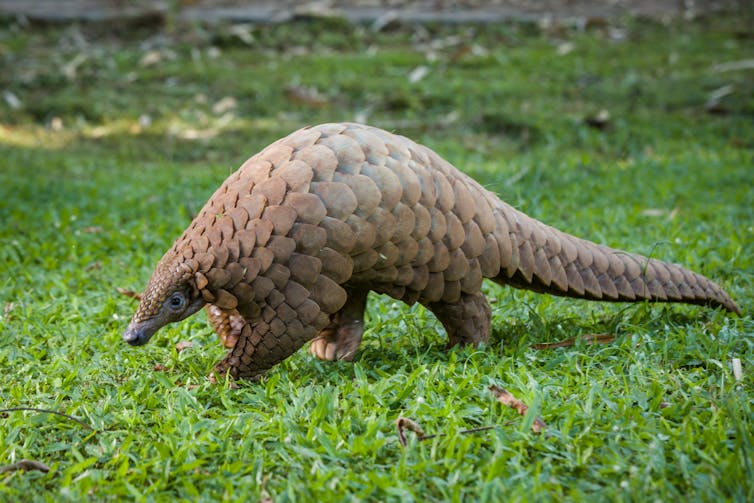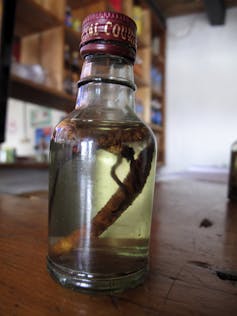
The bright blue blood of the horseshoe crab is used around the world to detect bacterial contamination in vaccines. Synonymous with luxury, sturgeon caviar has been patented as an antidote to impotency in China. Rhino horn is used in traditional Asian medicine to treat various ailments, and is also an ingredient in 50 different recipes for snuff.
Similarly, pangolin scales have been suggested as an ingredient in livestock feed, according to a 2014 patent. Wildlife products, even those that have been traded and used for centuries, are the subject of constant innovation, and that could be putting rare and endangered animals under increasing pressure.
Market shifts are usually detected after trade – either legal or illegal – has become established. Since 2014, jaguar parts began replacing the more rare and difficult to obtain tiger parts in Chinese markets. As businesses make technological advances, they apply for patents to protect their commercial interest.
These patent applications document changes in species, products and locations of wildlife trade. So patents can provide a window into innovations related to wild products.
In our new research, published in the journal Nature Communications, we analysed the patents for products sourced from various species. We selected bears, Ophiocordyceps caterpillar fungus, rhinos, pangolins, sturgeon and horseshoe crabs, to cover a range of use types, taxonomic groups and trade legalities. Using machine learning, we analysed half a century of wildlife-related patenting, looking at patents from 1970-2020.

We used a method called “changepoint analysis” to look for the key point at which patent filing rate changed, and also “topic modelling”, which grouped together patents with similar topics (such as medicine, food or farming) based on a set of keywords. We could then pinpoint key moments when patent filing rates shifted and explore when or how commercial interest changed.
We found 27,308 patent applications for the species we focused on in this study. Patent filing rates for them increased at 130% per year since 1988, more than the average of 104% for all patent filing. On a global scale businesses consider wild species an important component of future commercial trade.
While we expected that legislative bans would reduce patenting rates for products using wild species, and potentially increase patent filing for alternatives, this was not the case. Changes in patent filing trends did not always coincide with regulations such as trade bans.
Patents filed for illegal products also increased. For example, 426 patents for medicines containing rhino horn were filed in China after it was banned as a medicinal ingredient there. This included a proposed treatment for blood disease in 2016 and an anti-cancer food supplement in 2013.
This may suggest that, in most cases, businesses have some confidence that these markets will reopen in the future. It could also indicate that the people filing patents are unaware of these regulations.
One exception was a decrease patent applications for products containing pangolins and an increase in patenet applications for patents related to farming patents, for example formula for feeding young pangolins, in 2017. This was the year when pangolins were legally protected by the Convention on International Trade in Endangered Species in the equivalent of an international commercial trade ban.
Innovative applications
Patents diversified over time. This included the emergence of applications for horseshoe crab blood in the electronics industry in the 1980s, and a new “environmentally-friendly” pesticide containing rhino horn, which was patented in 2013.

Sometimes existing products are promoted for a new purpose. Cordyceps, a caterpillar controlled by an infecting fungus collected in the high altitude Himalayas, was a popular traditional medicine and food supplement.
Demand for these products soared after they were named as a performance enhancer for athletes at the Beijing Olympics. The medicinal use of pangolin scales was the basis for a 2019 patent for healthcare trousers, which have a pouch containing pangolin scales and other medicinal ingredients.
Innovations aimed at expanding markets and increasing profits for businesses can lead to more wild harvest and trade of animals, plants and fungi to meet demand. However, innovation can also focus on reducing wild trade through improved farming as an alternative to wild collecting.
For example, there are patents for sturgeon breeding enclosures. Patents also include processes to produce synthetic versions of active ingredients, such as a bear bile substitute made from poultry bile in a lab.
Wildlife trade is subject to the same pressures and processes as other commercial sectors. Understanding how and why businesses innovate is key to understanding the future of wildlife markets. Even illegal trade is not based solely in hidden markets. Patents reveal a side of wildlife trade that has not been recognised or incorporated into decision making.
Conducting regular scans of patent applications could provide researchers with early warnings of emerging commercial interests that may lead to unsustainable or illegal harvesting. Policymakers and conservationists should use patent data to inform development of regulations and laws to identify businesses with a commercial interest in wildlife and better understand why and how they plan to use wild species.
Companies working to reduce the impact of their global supply chains on biodiversity may need to consider the potentially hidden uses of wild species in fertilisers and pesticides. They must also examine ingredients such as squalene, an oil extracted from shark livers for use in sunscreen, cosmetics and personal care products.
Unexpected use of wild species in widely available products increases the burden on consumers mindful of their impact on natural resources. Labelling requirements conceal wildlife used upstream of product manufacture.
For example, wild-collected wrasse are sometimes used to control lice in farmed salmon pens but this isn’t mentioned on any product labels. The more information that is available on hidden wild harvests, the greater the opportunity there is to reduce pressure on wild species.
Amy Hinsley receives funding from the Eric and Wendy Schmidt Foundation, the US Fish & Wildlife Service, and the Leventis Foundation.
Susanne Masters does not work for, consult, own shares in or receive funding from any company or organisation that would benefit from this article, and has disclosed no relevant affiliations beyond their academic appointment.
This article was originally published on The Conversation. Read the original article.







